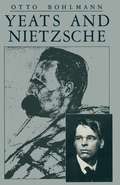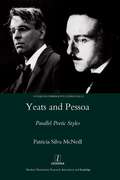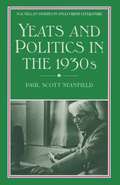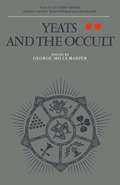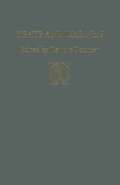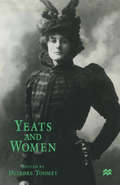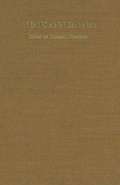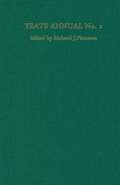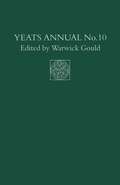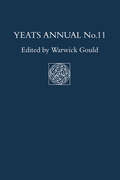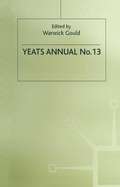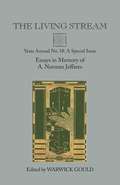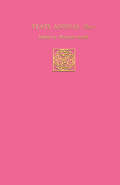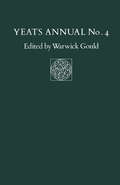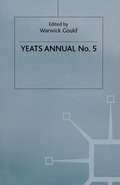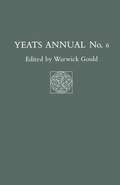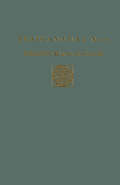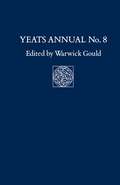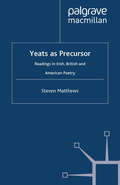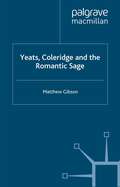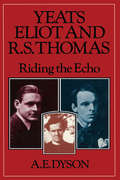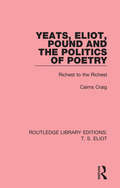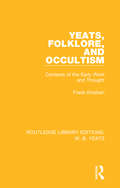- Table View
- List View
Yeats and Nietzsche: An Exploration of Major Nietzschean Echoes in the Writings of William Butler Yeats
by Otto BohlmannYeats and Pessoa: Parallel Poetic Styles
by Patricia Silva-McNeillW. B. Yeats and Fernando Pessoa (1888-1935) regarded style as a tool for metaphysical inquiry and, consequently, they adopted distinct poetic styles to convey different attitudes towards experience. Silva-McNeill's study examines how the poets' stylistic diversification was a means of rehearsing different existential and aesthetic stances. It identifies parallels between their styles from a comparative case studies approach. Their stylistic masks allowed them to maintain the subjectivity and authenticity associated with the lyrical genre, while simultaneously attaining greater objectivity and conveying multiple perspectives. The poets continuously transformed the fond and form of their verse, creating a protean lyrical voice that expressed their multilateral poetic temperament and reflected the depersonalisation and formal experimentalism of the modern lyric.
Yeats and Pessoa: Parallel Poetic Styles
by Patricia Silva-McNeillW. B. Yeats and Fernando Pessoa (1888-1935) regarded style as a tool for metaphysical inquiry and, consequently, they adopted distinct poetic styles to convey different attitudes towards experience. Silva-McNeill's study examines how the poets' stylistic diversification was a means of rehearsing different existential and aesthetic stances. It identifies parallels between their styles from a comparative case studies approach. Their stylistic masks allowed them to maintain the subjectivity and authenticity associated with the lyrical genre, while simultaneously attaining greater objectivity and conveying multiple perspectives. The poets continuously transformed the fond and form of their verse, creating a protean lyrical voice that expressed their multilateral poetic temperament and reflected the depersonalisation and formal experimentalism of the modern lyric.
Yeats And Politics In The 1930s (Macmillan Studies In Anglo-irish Literature Ser.)
by Paul S StanfieldYeats and Women: Yeats Annual No 9 (Yeats Annual)
by Deidre ToomeyYeats and Women is a special issue of the distinguished Yeats Annual series and is the first collection of essays upon W.B.Yeats to focus upon his relation to women. Its critical and biographical approaches employ feminist and psychoanalytic theory, and social anthropology. The seventeen plates (many hitherto unpublished) include the tomb and coffin of Maud Gonne's first child, Florence Farr's occult Egyptian shrine, and the last photograph of Yeats.
Yeats and Women
by Deirdre ToomeyYeats and Women , published originally in the Yeats Annuals series, collects eight essays on Yeats's relationships with women, two collections of letters to him and his broadcast, 'Poems about Women'. The essays cover sexuality and its dynamic in Yeats's writing: his attitude to feminism and to the 'feminist occult'; his relationships with Maud Gonne, Dorothea Hunter, Olivia Shakespear, Florence Farr, Iseult Gonne and George Yeats. Yeats's relationship with Lady Gregory and her co-authorship of Cathleen ni Houlihan is analysed. The collection includes 12 plates.
Yeats Annual: An Annual Of Critical And Textual Studies 1995 (Macmillan Literary Annuals #13)
by Richard J. FinneranYeats Annual: An Annual Of Critical And Textual Studies 1995 (Yeats Annual #13)
by Richard J. FinneranYeats Annual No. 10 (Yeats Annual)
by Warwick GouldYeats Annual No. 10 finds new thresholds and margins in Yeats's thought and work. It concentrates upon his plays, his occult concerns with spiritualism and the Irish belief in an otherworld, and closely examines certain aspects of his textual state and the borders of his canon. 'The admirable Yeats Annual ... a powerful base of biographical and textual knowledge. Since 1982 the vade mecum of ... Yeats ... full of interest'. Bernard O'Donoghue, The Times Literary Supplement
Yeats Annual No. 11 (Yeats Annual)
by Warwick GouldYeats Annual No. 11 has four broad themes: W.B. Yeats's written and oral poetic technique; his philosophical interests in Eastern thought and A Vision; his manuscripts: and Jack B. Yeats's work, including his illustrations for his brother's writing. The contributions include: Michael Sidnell on Yeats's 'Written Speech'; Helen Vendler on Yeats and Ottava Rima; Steve Ellis on Chaucer, Yeats and the Living Voice; P.S. Sri on Yeats and Mohini Chatterjee; Matthew Gibson and Colin McDowell on A Vision and the automatic script; Wayne Chapman on the 'Countess Cathleen Row' of 1899 and revisions to the play; Warwick Gould and Deirdre Toomey on The Flame of the Spirit; Hilary Pyle on Jack B. Yeats's Illustrations for his Brother; John Purser's edited transcript of Jack Yeats and Thomas MacGreevy in conversation. There are shorter notes by Morton D. Paley, A.Norman Jeffares, Lis Pihl and others. Fourteen new books are reviewed and the nine plates include hitherto unpublished images.
Yeats Annual No. 13 (Yeats Annual)
by Warwick GouldYeats Annual is the leading international research-level journal devoted to the greatest twentieth-century poet in the English language. In this number there are new essays on Yeats's theatre by leading scholars such as Richard Allen Cave, Gregory N. Eaves and Masaru Sekine, while scholars from nine countries including Peter L. Caracciolo and Paul Edwards, Maneck H. Daruwala, William F. Halloran, Elisabeth Heine and Colleen MacKenna address such matters as 'Yeats and Maud Gonne: Marriage and the Astrological Record, 1908-9', Yeats's relations with Fiona Macleod and with Wyndham Lewis, the Ghost of Wordsworth, Philip Larkin and Seamus Heaney. There are new essays on A Vision , shorter bibliographical notes and reviews of ten new studies.
Yeats Annual No. 18
by Warwick GouldYeats Annual No. 18 is another special issue in this renowned research-level series offering a tribute to the pioneering Yeats scholar, A. Norman Jeffares. Memories of the man are shared by Seamus Heaney, Christopher Rush and Colin Smythe, who compiles a bibliography of Jeffares's work. Terence Brown, Neil Corcoran, Warwick Gould, Joseph M. Hassett, Phillip L. Marcus, Ann Saddlemyer, Ronald Schuchard, Deirdre Toomey and Helen Vendler offer essays on such topics as Yeats and the Colours of Poetry, Yeats's Shakespeare, Yeats and Seamus Heaney, Lacrimae Rerum and Tragic Joy, Raftery's work on Yeats's Thoor Ballylee, Edmund Dulac's portrait of Mrs George Yeats, The Tower as an anti-Modernist monument, with close studies of 'Vacillation', 'Her Triumph', and 'The Cold Heaven'. Throughout, the essays are inflected with memories of Jeffares and his critical methods. The volume is rounded with further essays on A Vision by Neil Mann and Matthew de Forrest, while reviews of recent editions and studies are provided by Matthew Campbell, Wayne K. Chapman, Sandra Clark, Denis Donoghue, Nicholas Grene, Joseph M. Hassett, and K.P.S. Jochum. Yeats Annual is published by Open Book Publishers in association with the Institute of English Studies. Further details, including how to order back issues, can be found at: http://www.ies.sas.ac.uk/publications/yeats-annual
Yeats Annual No 6 (Yeats Annual)
by Warwick GouldThis research-level publication for current thought and documentation upon the life and work of Yeats, focuses on Yeats at work on various manuscripts and on his tours of America. Two of his poems are published from manuscript for the first time.
Yeats Annual No 7: including Essays in Memory of Richard Ellmann (Yeats Annual)
by Warwick GouldThe essays in Yeats Annual No 7 are dedicated to the memory of Richard Ellmann, one of the great pioneer critics of W.B.Yeats. They have been contributed by distinguished colleagues and friends of Richard Ellmann, chosen on his advice. The volume also contains much new material by Yeats himself - a new and virtually complete early draft of his novel The Speckled Bird, here entitled 'The Lilies of the Lord' and two new poems from The Flame of the Spirit manuscript book, given to Maud Gonne in 1981.
Yeats Annual No. 8 (Yeats Annual)
by Warwick GouldYeats Annual No.8 has two distinct themes: Yeats's poetic technique and his aims for an Irish Theatre. Essays from Helen Vendler, Richard Taylor, Timothy Armstrong and Wayne Chapman place the poetry under close scrutiny and offer challenging new studies. Yeats himself writes the remaining essays, including the long-awaited first publication of his Wildean dialogue and an uncollected address on the Irish National Theatre delivered in 1934. Richard Londraville edits four of Yeats's lectures given in England and America in 1902-4.
Yeats as Precursor: Readings in Irish, British and American Poetry
by S. MatthewsAs both a late Romantic and a modern, W.B. Yeats has proved to be perhaps the most influential poet of the early twentieth-century. In this original study Steven Matthews traces, through close readings of significant poems, the flow of Yeatsian influence across time and cultural space. By engaging with the formalist criticism of Harold Bloom and Paul de Man in their dialogues with Jacques Derrida, he also considers Yeats's significance as the founding presence within the major poetry criticism of the century.
Yeats, Coleridge and the Romantic Sage
by M. GibsonThis work explores an aspect of Yeats's writing largely ignored until now: namely, his wide-ranging absorption in S.T. Coleridge. Gibson explores the consistent and densely woven allusions to Coleridge in Yeats's prose and poetry, often in conjunction with other Romantic figures, arguing that the earlier poet provided him with both a model of philosopher - 'the sage' - and an interpretation of metaphysical ideas which were to have a resounding effect on his later poetry, and upon his rewriting of A Vision.
Yeats, Eliot, Pound and the Politics of Poetry: Richest to the Richest (Routledge Library Editions: T. S. Eliot)
by Cairns Prof. CraigIt has long been recognised that there is an apparently paradoxical relationship between the revolutionary poetic style developed by Yeats, Eliot and Pound in the period during and after the First World War, and the reactionary politics with which they were associated in the 1920s and 1930s. Concentrating on their writings in the period up to the 1930s, this study, first published in 1982, helps to resolve the paradox and also provides a much needed reappraisal of the factors influencing their poetic and political development. The work of these poets has usually been seen as deriving from the tradition of continental symbolist poetics. Yeats, Eliot, Pound and the Politics of Poetry will be of interest to students of literature.
Yeats, Eliot, Pound and the Politics of Poetry: Richest to the Richest (Routledge Library Editions: T. S. Eliot #2)
by Cairns Prof. CraigIt has long been recognised that there is an apparently paradoxical relationship between the revolutionary poetic style developed by Yeats, Eliot and Pound in the period during and after the First World War, and the reactionary politics with which they were associated in the 1920s and 1930s. Concentrating on their writings in the period up to the 1930s, this study, first published in 1982, helps to resolve the paradox and also provides a much needed reappraisal of the factors influencing their poetic and political development. The work of these poets has usually been seen as deriving from the tradition of continental symbolist poetics. Yeats, Eliot, Pound and the Politics of Poetry will be of interest to students of literature.
Yeats, Folklore and Occultism: Contexts of the Early Work and Thought (Routledge Library Editions: W. B. Yeats)
by Frank KinahanThis lively introduction to the poems of W. B. Yeats, first published in 1988, provides a series of intriguing new readings of his work in relation to his profound involvement with occultism and folklore. During Yeats’s formative years as an artist, two compelling movements were emerging: the revivals of interest in Irish folklore and in the mag
